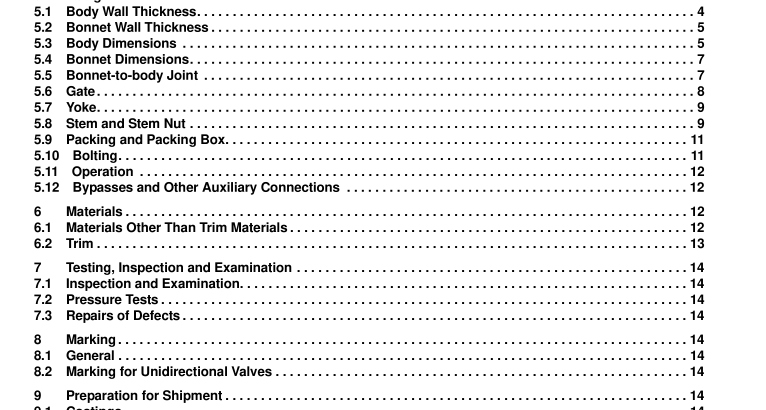API 600:2009 pdf free download.Steel Gate Valves—Flanged and Butt-welding Ends, Bolted Bonnets
3 Definitions
3.1 Class An alphanumeric designation that is used for reference purposes relating to valve pressure/temperature capability, taking into account valve material mechanical properties and valve dimensional characteristics. It comprises “Class” followed by a dimensionless whole number. The number following “Class” does not represent a measurable value and is not used for calculation purposes except where specified in this International standard. The allowable pressure for a valve having a class number depends on the valve material and its application temperature and is to be found in tables of pressure/temperature ratings.
3.2 DN An alpha numeric designation of size that is common for components used in a piping system, used for reference purposes, comprising the letters “DN” followed by a dimensionless number indirectly related to the physical size of the bore or outside diameter of the end connection as appropriate.
The dimensionless number following “DN” does not represent a measurable value and is not used for calculation purposes except where specified. 3.3 NPS An alpha numeric designation of size that is common for components used in a piping system, used for reference purposes, comprising the letters “NPS” followed by a dimensionless number indirectly related to the physical size of the bore or outside diameter of the end connection as appropriate.
The dimensionless number may be used as a valve size identifier without the prefix “NPS.” The dimensionless size identification number does not represent a measurable value and is not used for calculation purposes.
4 Pressure/Temperature Ratings
4.1 Pressure/temperature ratings shall be in accordance with those specified in the tables of ASME B1 6.34 for standard class for the applicable material specification and the applicable class.
4.2 Restrictions of temperature and concurrent pressure, or pressure and concurrent temperature, (e.g. those imposed by special soft seals or special trim materials), shall be marked on the valve identification plate (see Section 8).
4.3 The temperature for a corresponding pressure rating is the maximum temperature of the pressure-containing shell of the valve. In general, this temperature is the same as that of the contained fluid. The use of a pressure rating corresponding to a temperature other than that of the contained fluid is the responsibility of the user.
4.4 For temperatures below the lowest temperature listed in the pressure/temperature tables the service pressure shall be no greater than the pressure for the lowest listed temperature. The use of valves at lower temperatures is the responsibility of the user. Consideration should be given to the loss of ductility and impact strength of many materials at low temperature.
4.5 Double seated valves, in some design configurations, may be capable of trapping liquid in the center cavity of the valve when in the closed position. If subjected to an increase in temperature, an excessive build-up of pressure can occur, which may result in a pressure boundary failure. Where such a condition is possible, it is the responsibility of the user to provide or require to be provided, means in design, installation, or operating procedure, to assure that the pressure in the valve does not exceed that allowed by this International standard for the resultant temperature.
5 Design
5.1 Body Wall Thickness
5.1.1 A valve body schematic is shown as Figure 1 . The minimum body wall thickness, t m , at the time of manufacture shall be as given in Table 1, except as indicated in 5.1 .2 for butt-welding valve ends. Additional metal thickness needed for assembly stresses, stress concentrations, and shapes other than circular shall be determined by individual manufacturers, since these factors vary widely.API 600 pdf download.API 600:2009 pdf free download
